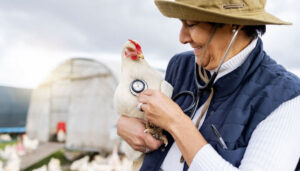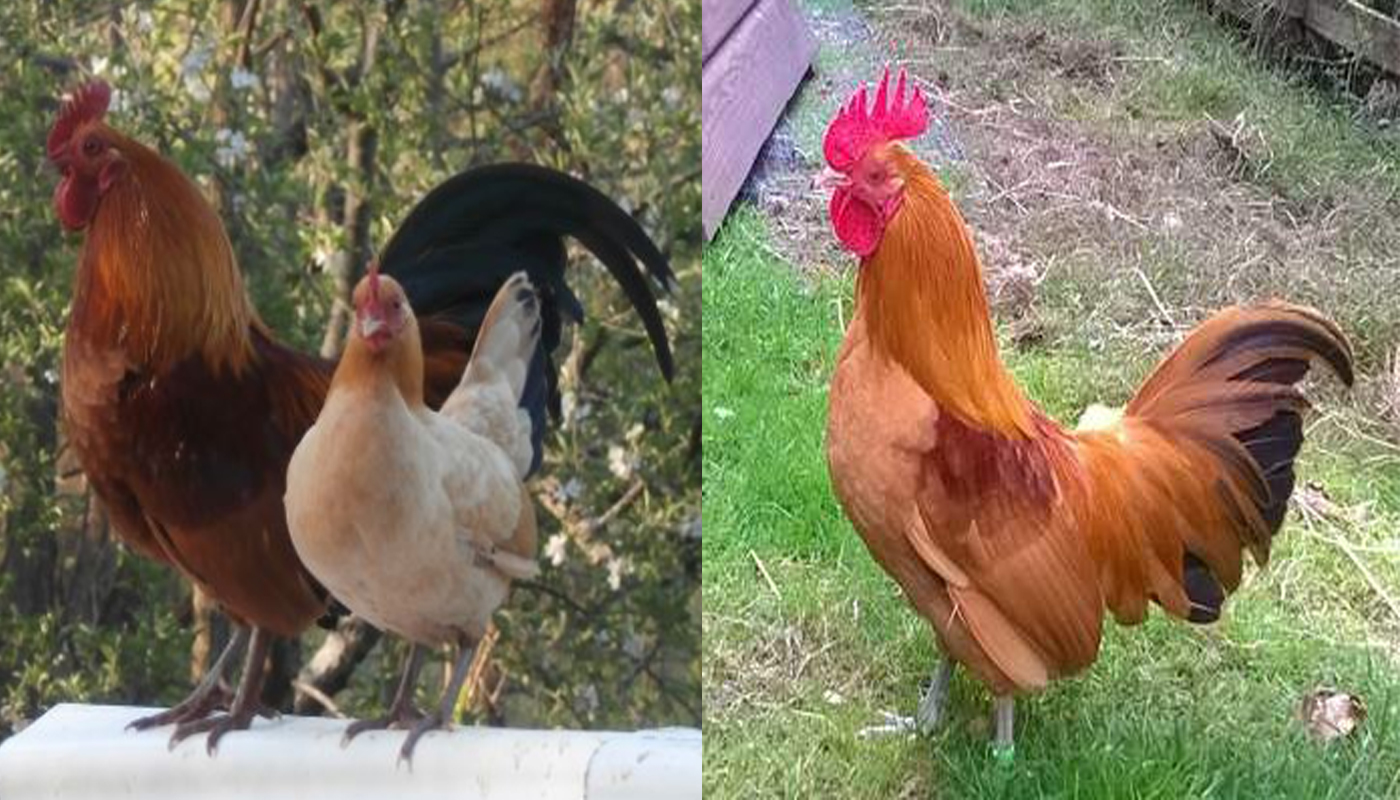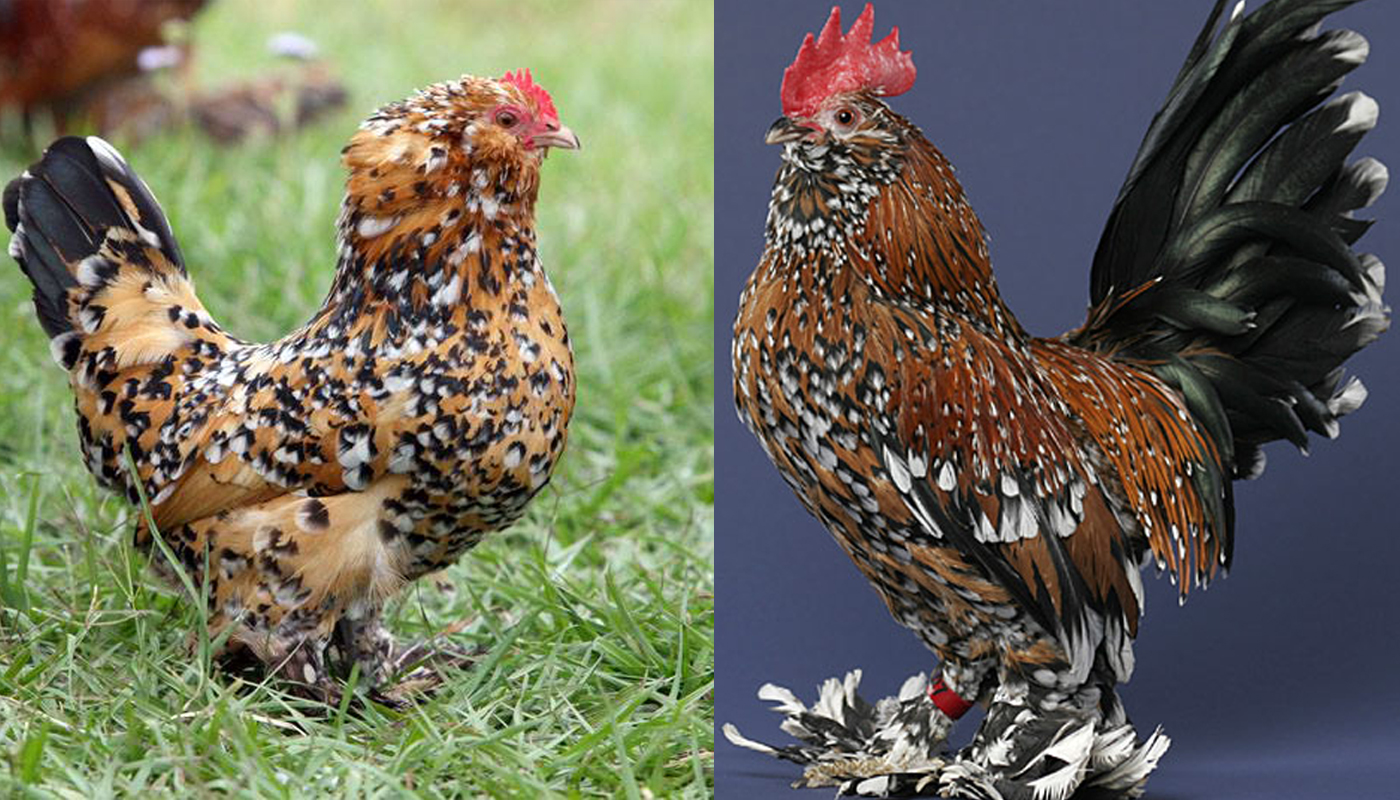
The Faverolles was once popular as a dual-purpose breed used for its medium to large light brown/pinkish colored eggs and tender white meat.
Today these colorful fluffy, bearded and booted chickens are mainly raised for exhibition or as a backyard coop chicken.
These French beauties are a delight and make excellent pets with their calm friend nature.
| Country of Origin: | France |
| American Poultry Association: | Recognized as a breed of chicken in the United States |
| Chicken Category: | Large Breed |
| Chicken Class: | Continental |
| Bantam Variety Available? | Yes – Feather Legged Bantam Classification |
| Good Starter Chicken? | They are a versatile low maintenance chicken with a docile, calm quiet and friendly nature that makes them perfect as a starter chicken. |
PURPOSE⇒ |
Eggs: They are good egg layers.
They lay medium sized light brown/pinkish eggs from 180 – 200 per year They will lay consistently throughout winter and summer They start to lay eggs from around 20 weeks old.
Meat: They have tender white meat making them a great table bird
Breeding: They can be bred and they hens do get broody, the make great brood hens and excellent mothers.
If you are breeding the Faverolles for show choosing the correct hens and rooster bloodline is crucial. As they are on the conservation threatened list the breeding should be done in conjunction with any rules or regulations that the conservancy may have applied to the Faverolle.
Foraging: They love to scratch and forage about. They do not mind confinement but would rather be out and about.
Show Bird: These beautiful colorful birds with their fluffy body, legs, feet and beard make for excellent show birds.
Pets: Their docile, gentle, calm and friendly nature makes them an excellent pet
Other: They do like to forage and roam about as they are active, alert birds that love to catch garden pests.
|
| Flyers? | They can fly but are not flighty |
| Noisy Birds? | They are quiet, timid birds |
| Interaction with other chickens: | They get along other breeds, but they tend to get bullied by other breeds of chickens due to their timid nature. It is best to keep only Favorelle or a breed such as the Sussex that will not bully them. Or keep them separate from more aggressive or push breeds. As with any flock if you are introducing new birds it is best to slowly socialize them with the flock. |
| Good with kids? | Their calm, gentle, docile nature make them excellent with children as they are also active, alert and very curious birds. They tend to delight kids with their antics as they play together. |
HISTORY
The Faverolles chicken originated in France and was developed to be a utility chicken. The breed was developed in the near vicinity of the village of Faverolles in north-central France.
The Faverolles were developed from breeds such as the Dorking, Brahma, Crevecoeur, Houdan, Cochin and Coucou de Rennes. Initially, they were developed for their meat, but they also proved to be good layers of decently sized eggs so became a true dual-purpose chicken.
The breed was sent to the United Kingdom in 1886 and then made its way to North America in the early 1900’s. In 1914 the Salmon variety of the Faverolles was admitted to the Standard of Perfection by the American Poultry Association. The white variety was admitted to the Standard in 1981. Although there are many color variations of the Faverolles they are not all recognized by the American Poultry Association.
The Salmon pattern of the Faverolles is the one that is most commonly thought of when one thinks of the breed. In 1905 the refined white variety was developed.
CHARACTERISTICS |
|
|---|---|
IDENTIFICATION⇒ |
Appearance/Body: Faverolles have rounded puffy feathered compact bodies. Little to no covered wattles, their earlobes are covered by muffs, they also have beards, feathered legs and feathered feet with five toes per foot.
Color(s) White and Salmon
Comb: They have a single comb.
Ave. Weight: Pullet/Hen 5 – 7 lbs.
Cockerel/Rooster 7 – 8 lbs. |
| Life Expectancy: | The average lifespan is 5 – 7 years |
| Health: | They have no known health issues and are quite a hardy bird. They are especially good in the cold, but their feet and legs must be kept clean and dry due to the excessive feathers on them. |
| You may Also Like: | HOW TO TELL IS A CHICKEN IS SICK |
| Temperament: | Calm, docile, gentle and friendly birds |
| Socialize Behavior? | They do not mind other animals but can be quite shy as they are timid chickens |
| You may Also Like: | HOW TO SOCIALIZING YOUR NEW CHICKENS |
| Known predators: | Most domestic animals leave them alone, but it is always best to keep an eye on dogs and cats. If hawks and or foxes are in your area it is always best to take precautions. Check with local animal shelters, zoos, vets, animal control and or pet stores about common predators in your area. |
| Conservation Status: | These birds conservation status is recorded as “threatened”. It is best to check on any special license or instructions that may be set up for owning these birds. This can be checked with your local or national conservation centers. |
IDEAL ENVIRONMENT |
|
|---|---|
| Garden Size: | They adapt well to most sized gardens and take confinement well. They do like to free range and forage about to stretch their legs. |
| Ideal Climate: | They are very hardy birds that handle the cold very well, but they need a lot of shady spots and cool water in the heat. They have a lot of plumage that tends to make them get quite hot. |
| Ideal Coop: | The rule of thumb for any coop is 50 cm x 50 cm per hen/rooster in the coop. Ensure there is a good space for the nesting boxes and nightly roosting rails at least 1.5 inches wide. Good ventilation for air but not too drafty especially in winter. It is always a good idea to raise the coop off the ground to give the birds a dry place to roost and lay especially in wet weather. |
| Ideal Coop Run: | They can fly if necessary, so it is a good idea to completely cover the coop run it will also keep the birds safe and secure from predators. |
| Ideal Flock Size: | They are quite happy in any size flock as long as the chickens are of the same temperament and do not bully them. |
| Special Instructions: | Other than their conservancy listing they do not require any special attention. |
| Accessories: | The following accessories are ideal for your coop: Nesting boxes Straw for the boxes and roosting area Roosting rails Perches Water troughs/bowls Food bowls/feeders Heating lamp(s) Animal carrier for transport purposes |
| You may Also Like: | 45 FREE DIY CHICKEN COOP PLANS, TUTORIALS AND DESIGNS |
WHERE TO FIND THESE BIRDS TO ADD TO YOUR FLOCK
These birds are quite rare in America although they may be found at some live poultry outlets and farms, or internet dealers such as Purely Poultry it is best to check with the Faverolles Breeders Club. Breeders clubs and the Livestock Conservancy will be able to help you find registered breeders with prime stock. They will also be able to help with any special requirements, attention or care they may need. If you plan on breeding your chickens, you will want to make sure that they are from a good bloodline.
CARING FOR THE BIRD(S)
Please click here for our full guide to “Taking care of chickens”. This is a comprehensive guide to owning chickens. It covers where to start from choosing your ideal flock, the coop that would best suit your garden, your bird and you to buying and bringing your bird(s) home.
GENERAL
Except for their conservation status, they are a low maintenance bird that are good for laying eggs and quite ornamental for your garden.
GROOMING
It is best to constantly check their leg and feet feathers to ensure they are clean and free of any pests or disease. This is important if they have been walking through water, wet ground or mud.
These chickens do love their dust bath and will love some added herbal essences mixed into the loose sand to help with pests and excess feather oils. Being a friendly calm bird that does not mind the attention of their owners checking them for mites, lice and various other parasites should not be too hard to do. Checking for these pests in their feathers should be done at least once a week to your chickens healthy. Always get your birds de-wormed on a regular basis especially if they are around other animals or interacting with kids.
DIET AND NUTRITION
Give your Faverolles a balanced diet of chicken pellets, grains, chicken mash or grain mix from 8 weeks old and older. This should be fed to them first thing in the morning before they are let out to roam about to ensure they are getting all their nutrients.
For baby chickens, the best is always Chick Starter when they are under 8 weeks old.
Laying hens should get extra protein and calcium in their diets to ensure the quality of their eggs and to keep them in tip-top health.
Faverolles is partial to being treated with table scraps in the form of vegetables and fruit. They find these scraps even better if they are served as ice-cubes on very hot days. This will help to cool them down in excessive heat.
Feeding your chickens correctly will give your organic garden a lot of nutritious fertilizer to make your vegetables or flowers grow.
Please see our comprehensive guide to “Feeding your chickens” for more information of the different types of chicken feed for chicks, hens, laying hens, roosters, etc. and where to buy the feed and approximate cost of the feed.
SOCIALIZING THE BIRD(S)
Faverolles are gentle docile birds that can be very timid. They tend to get along better with their own breed as other breeds have been known to bully them. If you are going to mix your flock, try a breed that has a similar disposition to the Faverolles like the Sussex breed.
Always check on how well a breed will get on with your current flock before buying them as you do not want to upset your coop or stress your current flock.
As with any newcomer to the roost, you will have to quarantine the bird for 7 – 31 days to ensure it does not have any unwanted critters or disease that could spread to your current flock.
It is advisable to socialize newcomers to the Faverolles flock slowly and determine when it is right to allow the newcomers to become a permanent part of the flock.
NOTES / SPECIAL INSTRUCTIONS
As they are registered as a “threatened” conservation status they may need an extra license to own or keep in your garden. For advice on what the bird’s conservation status and orders are please check with your local conservation department.
For breeders, it is imperative that you always check your bird’s bloodlines and ensure you are buying your birds from a reputed breeder/farm. In order to sell birds of such stature, they have to be recorded and documented, always check with local animal breeding organizations for these records.
These legitimate documents are also required should you wish to show your bird(s) in various poultry shows/competition showings.
For information and advice on adopting rescued animals, you can visit or contact your local animal welfare center.
Video
USEFUL LINKS
- Caring for your Chicken
- Feeding
- Health
- Socializing your Chicken
- Breeding Chicken
- Raising Chickens A-Z
- Hatching Eggs
- What is Molting
- Animal Shelter (ASPCA)
- American Veterinary Medical Association
- American Poultry Association
- American Animal Welfare Society
- American Animal Control
- American Animal Husbandry Society
References
- https://en.wikipedia.org
- https://livestockconservancy.org
- https://www.roysfarm.com
- https://www.mypetchicken.com
- https://www.backyardchickens.com
- https://www.feathersite.com/
 COMMON CAUSES OF HEALTH ISSUES,SYMPTOMS AND PREVENTATIVE MEASURES
COMMON CAUSES OF HEALTH ISSUES,SYMPTOMS AND PREVENTATIVE MEASURES The Basics of Chicken Health: Understanding Common Ailments and Prevention Strategies
The Basics of Chicken Health: Understanding Common Ailments and Prevention Strategies 45 FREE DIY CHICKEN COOP PLANS, TUTORIALS AND DESIGNS
45 FREE DIY CHICKEN COOP PLANS, TUTORIALS AND DESIGNS Common Digestive Disorders in Chickens: Symptoms, Treatment, and Prevention
Common Digestive Disorders in Chickens: Symptoms, Treatment, and Prevention 10 Chicken Breeds that have White Plumage
10 Chicken Breeds that have White Plumage Nankin Chicken Breed – Everything You Need to Know
Nankin Chicken Breed – Everything You Need to Know Belgian Bearded D’Uccle Chicken Breed – Everything You Need to Know
Belgian Bearded D’Uccle Chicken Breed – Everything You Need to Know Taking Care of Your Chicken Flock
Taking Care of Your Chicken Flock Future Trends in Chicken Breeding: Paving the Way for a Poultry Revolution
Future Trends in Chicken Breeding: Paving the Way for a Poultry Revolution 10 Beautiful Black and White Feathered Chicken Breeds
10 Beautiful Black and White Feathered Chicken Breeds HOW TO TELL IS A CHICKEN IS SICK
HOW TO TELL IS A CHICKEN IS SICK Planning and Housing a flock of chickens
Planning and Housing a flock of chickens